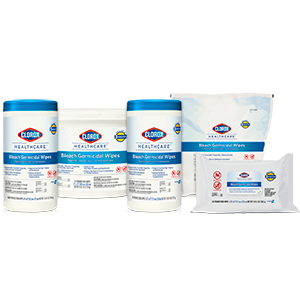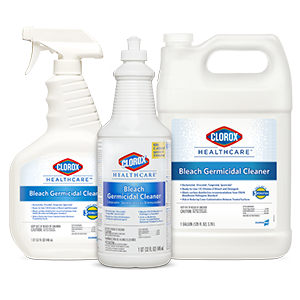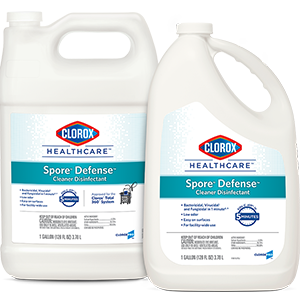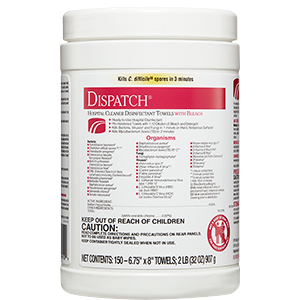What is C. diff (Clostridium difficile) & Cleaners to Kill Spores on Hard Surfaces
Overview

Clostridioides difficile (C. difficile or C. diff) is a spore-forming, toxin-producing bacterium that causes gastrointestinal conditions ranging from diarrhea to colitis.1 C. difficile is estimated to cause almost half a million infections annually in the United States. C. difficile infections commonly occur during or just after taking antibiotics, and can be life-threatening.2
Basic Facts
What is C. difficile?
C. difficile is an anaerobic, gram-positive bacillus that can exist in two forms: a dormant spore that has a tough protein coat, and a vegetative form that results from spore germination.3 The dormant spore is the infectious and transmissible form.4 Exposure to C. difficile spores can result in a C. difficile infection (CDI).
What are the symptoms of a C. difficile infection?
C. difficile can cause illness ranging from mild diarrhea to pseudomembranous colitis to toxic megacolon which is rare but life-threatening complication.5 In all cases, the major symptom of CDI is diarrhea. Mild cases may experience only watery diarrhea, while severe cases can include severe abdominal cramping, blood or pus in the stool, nausea, a swollen abdomen, kidney failure and an increased white blood cell count. Some patients require a colectomy — removal of the colon.6 Severe infection can lead to sepsis and death.7
How does C. difficile spread?
C. difficile is shed from feces. Contaminated environmental surfaces and skin can serve as a reservoir for C. difficile spores.8 Transmission occurs through the fecal-oral route. Spores can be shed by people with active C. difficile infection, as well as by asymptomatic carriers. Studies on the survival of C. difficile on hard surfaces such as those found in the healthcare environment showed that while the vegetative form dies within 24 hours, C. difficile spores can persist for months.9 This long survival period increases the risk of transmission from a contaminated surface that has not been properly cleaned and disinfected.
Why is C. difficile a concern?
C. difficile infections can be life-threatening. The risk of contracting a C. difficile infection increases in the elderly and in patients with previous antibiotic use, gastrointestinal surgery, immunocompromising conditions, and long stays in healthcare settings such as hospitals and nursing homes. About 1 in 6 patients who get a C. difficile infection will get it again within 2 to 8 weeks of initial infection.10
C. difficile Infection Control Measures
The CDC recommends the following steps for CDI prevention in healthcare:8
- Antibiotic stewardship: A program that promotes the appropriate use of antimicrobials11.
- Hand hygiene: Practice hand hygiene using soap and water; alcohol-based hand sanitizers do not inactivate C. difficile.
- Isolation: Rapidly identify and isolate patients with CDI in a private room. Dedicate equipment, as able, to the infected patient’s room.
- Diagnostic stewardship: Appropriate testing (e.g., test when indicated such as unexplained diarrhea).
- Personal Protective Equipment (PPE): Wear gloves and gowns when caring for C. difficile patients.
- Cleaning & disinfection: Clean CDI patient rooms daily and on discharge with an EPA-registered disinfectant with claims against C. difficile spores
- Interfacility communication: When a C. difficile patient transfers between facilities along the continuum of care, notify the receiving facility of the infection.
C. difficile Resources
Educational Resources
- C. diff Environmental Services Terminal Cleaning Protocol & Checklist
- C. diff Pathogen Education Sheet
- C. diff Prevention Tool Kit
- Bleach Facts: Your Defense Against the Toughest HAI-Causing Pathogens
- Poster Presentation: Electrostatic Devices Against C. difficile
- Electrostatic Sprayers: A New Way to Combat C. difficile in Healthcare
- Three-Part Series: Cleaning & Disinfection — From Basics to Innovation
- Infection Prevention in Long-Term Care: Focus on the Environment
Clinical Evidence
- Bleach-Based Disinfectants in Healthcare Settings – Summary of Clinical Evidence
- Clorox Healthcare® Spore Defense Electrostatics vs. UV-C Research Study
- Electrostatic Devices Against C. difficile Poster
- Impact of Clorox® Total 360® System with Clorox Healthcare® Spore Defense® Cleaner Disinfectant in Healthcare Settings
- Evaluation of an Electrostatic Spray Disinfectant Technology
- Evaluation of a novel sporicidal spray disinfectant for decontamination of surfaces in healthcare Poster
- Impact of Routine Use of a Spray Formulation of Bleach on C. difficile
Blog Posts
Products for Use Against C. difficile
Cleaning & Disinfecting
It is important to clean surfaces potentially contaminated with C. diff before disinfecting. The CDC recommends use of a disinfectant that is registered with the Environmental Protection Agency (EPA) and is effective against C. difficile (see EPA List K).12 It is important to follow the directions for use, including applying the product for the correct contact time. Specifically, the CDC recommends:
- Disinfect occupied isolation rooms and restrooms twice daily with a C. difficile sporicidal disinfectant such as bleach, with special attention to high-touch surfaces.
- For terminal cleaning, use a C. difficile sporicidal disinfectant after CDI patient transfer or discharge. Consider use an adjunct disinfecting technology upon completion of manual cleaning and disinfection.
- Disinfect areas potentially contaminated during transient visits by patients with suspected or confirmed CDI, including waiting rooms.
- Medical equipment should be disinfected after each patient.
Clorox Healthcare Product Recommendations
The following Clorox Healthcare® cleaner disinfectants can be used to effectively manage C. difficile on environmental surfaces and equipment in healthcare settings:
Cleaning & Disinfecting
It is important to clean surfaces potentially contaminated with C. diff before disinfecting. The CDC recommends use of a disinfectant that is registered with the Environmental Protection Agency (EPA) and is effective against C. difficile (see EPA List K).12 It is important to follow the directions for use, including applying the product for the correct contact time. Specifically, the CDC recommends:
- Disinfect occupied isolation rooms and restrooms twice daily with a C. difficile sporicidal disinfectant such as bleach, with special attention to high-touch surfaces.
- For terminal cleaning, use a C. difficile sporicidal disinfectant after CDI patient transfer or discharge. Consider use an adjunct disinfecting technology upon completion of manual cleaning and disinfection.
- Disinfect areas potentially contaminated during transient visits by patients with suspected or confirmed CDI, including waiting rooms.
- Medical equipment should be disinfected after each patient.
Clorox Healthcare Product Recommendations
The following Clorox Healthcare® cleaner disinfectants can be used to effectively manage C. difficile on environmental surfaces and equipment in healthcare settings:
| Germicidal Wipes EPA Reg. No. 67619-12 5″ x 6″ Clinical Wipes, 6/150 ct., Item No. 30577 6.75″ x 9″ Multi-purpose Wipes, 6/70 ct., Item No. 35309 6.75″ x 9″ Multi-purpose Wipes, 6/100 ct., Item No. 32621 12″ x 12″ Terminal Wipes, 2/110 ct., Item No. 30358 12″ x 12″ Terminal Wipes Refill, 2/110 ct., Item No. 30359 |
 |
|
| Germicidal Cleaners EPA Reg. No. 56392-7 6/32 fl. oz. Spray, Item No. 68970 6/32 fl. oz. Pull-Top, Item No. 68832 4/128 fl. oz. Refill, Item No. 68978 |
 |
|
| Fuzion® EPA Reg. No. 67619-30 9/32 fl. oz. Spray, Item No. 31478 |
 |
|
| Clorox Healthcare® Spore Defense® Cleaner Disinfectant EPA Reg. No. 67619-40 4/128 fl. oz., Item No. 32122 4/128 fl. oz., Item No. 32409 |
 |
|
| Hospital Cleaner Disinfectant Towels with Bleach EPA Reg. No. 56392-8 6.75″ x 9″ Multi-purpose Wipes, 6/70 ct., Item No. 35309 |
 |
References
1. Mayo Clinic. C. difficile infection https://www.msn.com/en-us/health/medical/c-difficile-infection/ar-AA10kZS6?li=BBnba9O (accessed Aug 11, 2022).
2. Centers for Disease Control and Prevention (CDC). C. diff (Clostridioides difficile) https://www.cdc.gov/cdiff/index.html (accessed Aug 11, 2022).
3. Centers for Disease Control and Prevention (CDC). FAQs for Clinicians about C. diff https://www.cdc.gov/cdiff/clinicians/faq.html#what-is (accessed Aug 11, 2022).
4. Paredes-Sabja, D.; Shen, A.; Sorg, J. A. Clostridium Difficile Spore Biology: Sporulation, Germination, and Spore Structural Proteins. Trends Microbiol. 2014, 22 (7), 406–416. https://doi.org/10.1016/J.TIM.2014.04.003.
5. Johns Hopkins Medicine. Toxic Megacolon https://www.hopkinsmedicine.org/health/conditions-and-diseases/toxic-megacolon (accessed Aug 11, 2022).
6. Surgical management of Clostridioides (formerly Clostridium) difficile colitis in adults https://www.uptodate.com/contents/surgical-management-of-clostridioides-formerly-clostridium-difficile-colitis-in-adults (accessed Aug 11, 2022).
7. Centers for Disease Control and Prevention. What is C. diff? https://www.cdc.gov/cdiff/what-is.html (accessed Aug 11, 2022).
8. Centers for Disease Control and Prevention. FAQs for Clinicians about C. diff https://www.cdc.gov/cdiff/clinicians/faq.html (accessed Aug 11, 2022).
9. Kramer, A.; Schwebke, I.; Kampf, G. How Long Do Nosocomial Pathogens Persist on Inanimate Surfaces? A Systematic Review. BMC Infect. Dis. 2006, 6. https://doi.org/10.1186/1471-2334-6-130.
10. Guh, A. Y.; Mu, Y.; Winston, L. G.; Johnston, H.; Olson, D.; Farley, M. M.; Wilson, L. E.; Holzbauer, S. M.; Phipps, E. C.; Dumyati, G. K.; Beldavs, Z. G.; Kainer, M. A.; Karlsson, M.; Gerding, D. N.; McDonald, L. C. Trends in U.S. Burden of Clostridioides Difficile Infection and Outcomes . N. Engl. J. Med. 2020, 382 (14), 1320–1330. https://doi.org/10.1056/NEJMOA1910215/SUPPL_FILE/NEJMOA1910215_DISCLOSURES.PDF.
11. Association for Professionals in Infection Control and Epidemiology. Antimicrobial stewardship https://apic.org/professional-practice/practice-resources/antimicrobial-stewardship/ (accessed Aug 11, 2022).
12. Environmental Protection Agency. List K: EPA’s Registered Antimicrobial Products Effective against Clostridium difficile Spores https://www.epa.gov/pesticide-registration/list-k-epas-registered-antimicrobial-products-effective-against-clostridium (accessed Aug 11, 2022).



